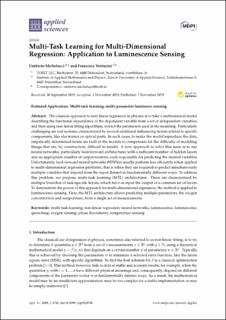Bitte benutzen Sie diese Kennung, um auf die Ressource zu verweisen:
https://doi.org/10.21256/zhaw-18733| Publikationstyp: | Beitrag in wissenschaftlicher Zeitschrift |
| Art der Begutachtung: | Peer review (Publikation) |
| Titel: | Multi-task learning for multi-dimensional regression : application to luminescence sensing |
| Autor/-in: | Michelucci, Umberto Venturini, Francesca |
| et. al: | No |
| DOI: | 10.3390/app9224748 10.21256/zhaw-18733 |
| Erschienen in: | Applied Sciences |
| Band(Heft): | 9 |
| Heft: | 22 |
| Erscheinungsdatum: | 2019 |
| Verlag / Hrsg. Institution: | MDPI |
| ISSN: | 2076-3417 |
| Sprache: | Englisch |
| Schlagwörter: | Artificial intelligence; Machine learning; Oxygen sensor; Luminescence |
| Fachgebiet (DDC): | 004: Informatik 530: Physik |
| Zusammenfassung: | The classical approach to non-linear regression in physics is to take a mathematical model describing the functional dependence of the dependent variable from a set of independent variables, and then using non-linear fitting algorithms, extract the parameters used in the modeling. Particularly challenging are real systems, characterized by several additional influencing factors related to specific components, like electronics or optical parts. In such cases, to make the model reproduce the data, empirically determined terms are built in the models to compensate for the difficulty of modeling things that are, by construction, difficult to model. A new approach to solve this issue is to use neural networks, particularly feed-forward architectures with a sufficient number of hidden layers and an appropriate number of output neurons, each responsible for predicting the desired variables. Unfortunately, feed-forward neural networks (FFNNs) usually perform less efficiently when applied to multi-dimensional regression problems, that is when they are required to predict simultaneously multiple variables that depend from the input dataset in fundamentally different ways. To address this problem, we propose multi-task learning (MTL) architectures. These are characterized by multiple branches of task-specific layers, which have as input the output of a common set of layers. To demonstrate the power of this approach for multi-dimensional regression, the method is applied to luminescence sensing. Here, the MTL architecture allows predicting multiple parameters, the oxygen concentration and temperature, from a single set of measurements. |
| URI: | https://digitalcollection.zhaw.ch/handle/11475/18733 |
| Volltext Version: | Publizierte Version |
| Lizenz (gemäss Verlagsvertrag): | CC BY 4.0: Namensnennung 4.0 International |
| Departement: | School of Engineering |
| Organisationseinheit: | Institut für Angewandte Mathematik und Physik (IAMP) |
| Enthalten in den Sammlungen: | Publikationen School of Engineering |
Dateien zu dieser Ressource:
| Datei | Beschreibung | Größe | Format | |
|---|---|---|---|---|
| 2019_Venturini_MultiTask Learning for MultiDimensional Regression_ApplSci.pdf | 1.49 MB | Adobe PDF |  Öffnen/Anzeigen |
Zur Langanzeige
Michelucci, U., & Venturini, F. (2019). Multi-task learning for multi-dimensional regression : application to luminescence sensing. Applied Sciences, 9(22). https://doi.org/10.3390/app9224748
Michelucci, U. and Venturini, F. (2019) ‘Multi-task learning for multi-dimensional regression : application to luminescence sensing’, Applied Sciences, 9(22). Available at: https://doi.org/10.3390/app9224748.
U. Michelucci and F. Venturini, “Multi-task learning for multi-dimensional regression : application to luminescence sensing,” Applied Sciences, vol. 9, no. 22, 2019, doi: 10.3390/app9224748.
MICHELUCCI, Umberto und Francesca VENTURINI, 2019. Multi-task learning for multi-dimensional regression : application to luminescence sensing. Applied Sciences. 2019. Bd. 9, Nr. 22. DOI 10.3390/app9224748
Michelucci, Umberto, and Francesca Venturini. 2019. “Multi-Task Learning for Multi-Dimensional Regression : Application to Luminescence Sensing.” Applied Sciences 9 (22). https://doi.org/10.3390/app9224748.
Michelucci, Umberto, and Francesca Venturini. “Multi-Task Learning for Multi-Dimensional Regression : Application to Luminescence Sensing.” Applied Sciences, vol. 9, no. 22, 2019, https://doi.org/10.3390/app9224748.
Alle Ressourcen in diesem Repository sind urheberrechtlich geschützt, soweit nicht anderweitig angezeigt.